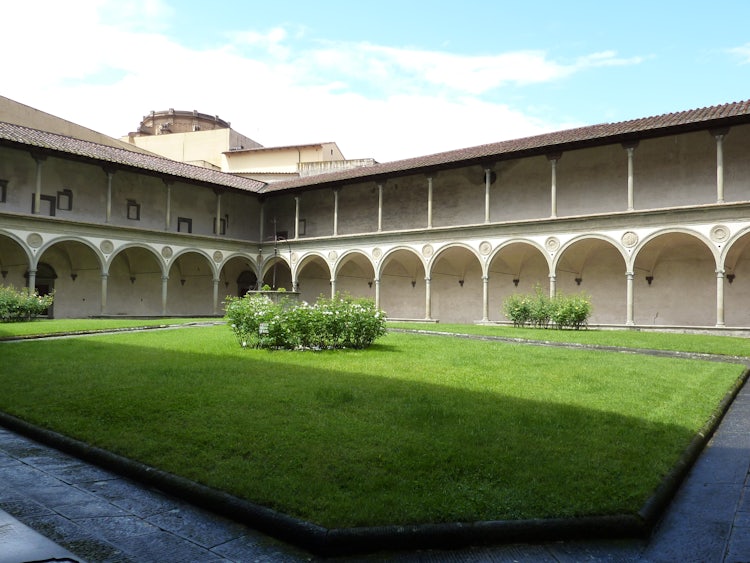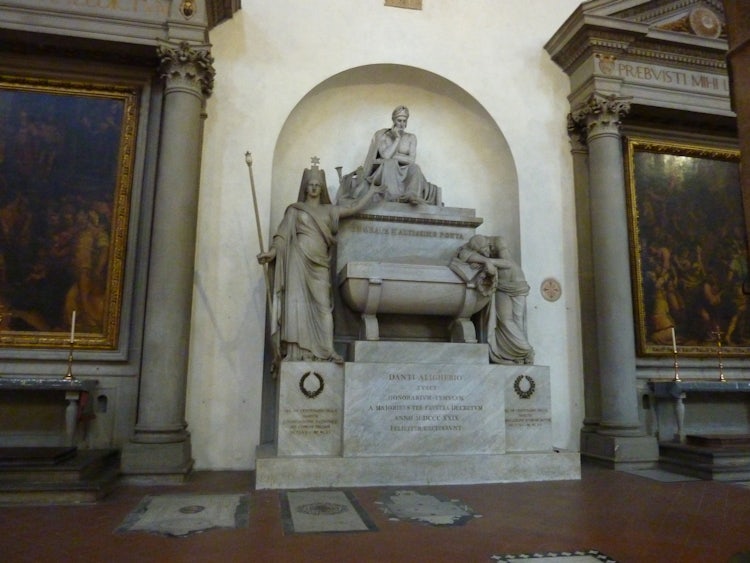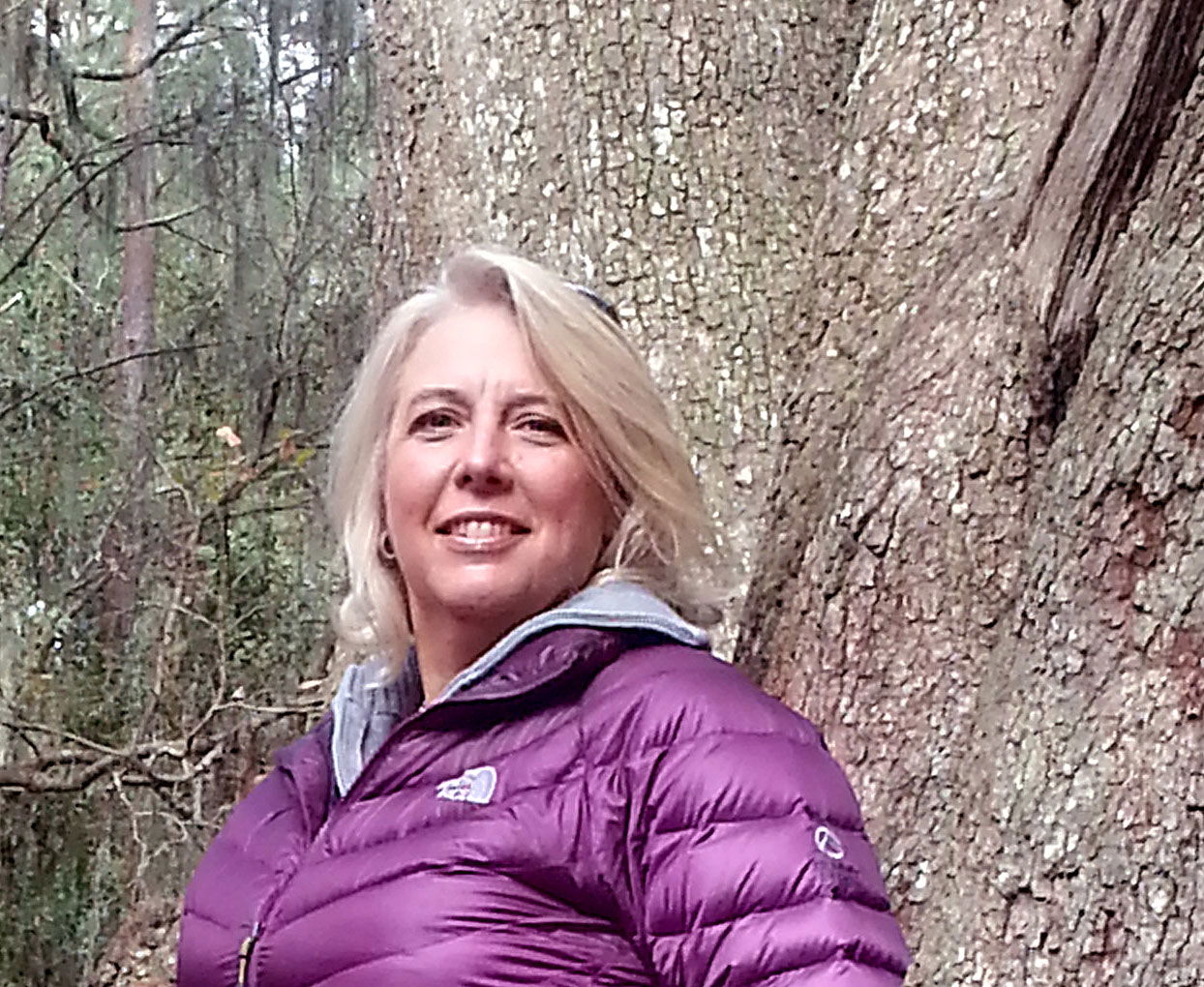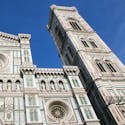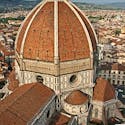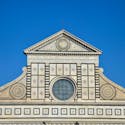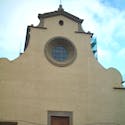Santa Croce, rebuilt for the Franciscan order in 1294 by Arnolfo di Cambio, is the burial place for the great and good in Florence. Michelangelo is buried in Santa Croce, as are Rossini, Machiavelli, and the Pisan-born Galileo Galilei, who was tried by the Inquisition and was not allowed a Christian burial until 1737, 95 years after his death. There is also a memorial to Dante, but his sarcophagus is empty (he is actually buried in Ravenna as he was exiled from Florence).
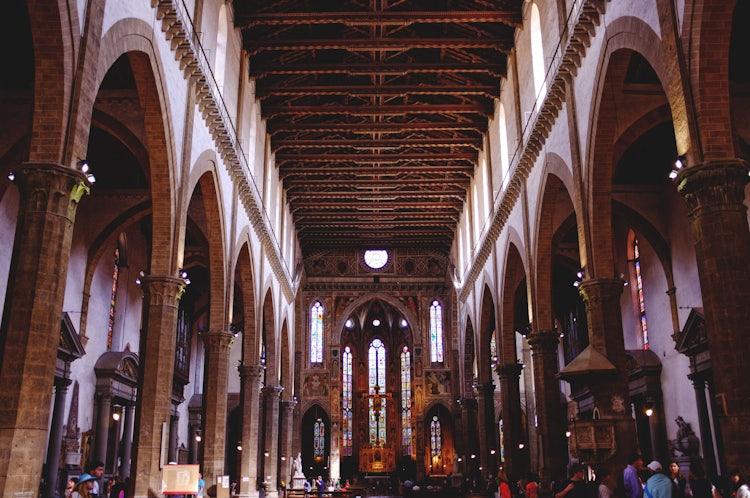
There is an immense artistic wealth in Santa Croce; frescoes (1380) by Gaddi in the Cappella Maggiore tell the story of the holy cross, "santa croce", and beautiful frescoes by Giotto in the Bardi and Peruzzi Chapels show scenes from the life of St. Francis and St. John the Evangelist. An unusual relief, the Annunciation, in gilded limestone by Donatello decorates the south nave wall. Don't miss the memorial to the 19th century playwright Giovanni Battista Niccolini to the left of the entrance said to be been the inspiration for the Statue of Liberty.
Below we have compiled a mini guide of the highlights of the church as you walk through its hallowed walls. For more information off opening hours and tickets please see the left navigation bar.
The church of Santa Croce was severely hit by the flood of 1966, a tide plate shows how far up on the pillars and walls.

Just what are you looking at?
Santa Croce, positioned outside of the city walls (article link) until …. is one of the more prominent and recognisable churches in the city of Florence. Before we delve into the interior - here are just a few dates to start you off with:
The original structure dates from 1212 when St. Francis of Assisi visited Florence, later with a group of his followers, he settled in the city, choosing an inhospitable, marshy area just outside the city walls. This original architectural base was re-discovered after the flood in 1966.
The present building began on the 3rd of May 1294 or 1295 (the year is not certain) the erection of the present church began and took years to finish
The church exterior is covered with a polychrome marble façade added in 1863 and paid for by the English benefactor, Sir Francis Sloane. It looks onto the Piazza Santa Croce, which is the site of the annual soccer game in medieval costume, the Calcio Storico Fiorentino.
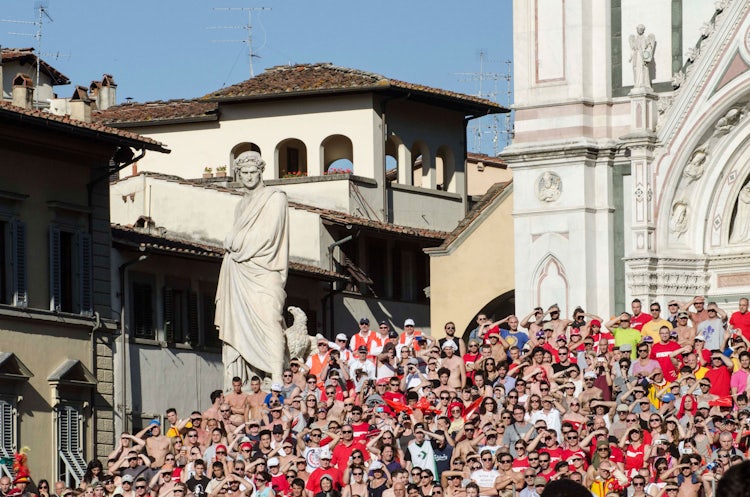
Bell Tower
Santa Croce stone
Forever flaunting their cheeky sense of humour, the Florentines have often referred to the bell tower, which stood unfinished for over a 100 years, as "il sasso" or the stone. Over 78 meters tall. it is located to the right of the church within the cloister. The original bell tower built above the apse of the Church fell down in 1512 and Francesco da Sangallo was asked to design another one but soon were interrupted due to the lack of funds. Everything came to a standstill until the 1800s when it was finally finished.
Crypt
Rediscovered after flood in 1844, and used as a storage space until the 1930 as a war memorial. The interventions to transform the foundations into a shrine were carried out in 1934 by Alfredo Lensi.
16 Chapels
There are sixteen family chapels that help compose the Santa Croce Basilica, considered the largest Franciscan church in the world and legend tells us that that Santa Croce was founded by St Francis himself. Well-to-do families typically had chapels built and decorated in their honor (and often to appease the church or seek forgiveness for sins they were unwilling to stop committing) and dedicated to a favorite saint. Below are highlights of some of the more famous chapels.
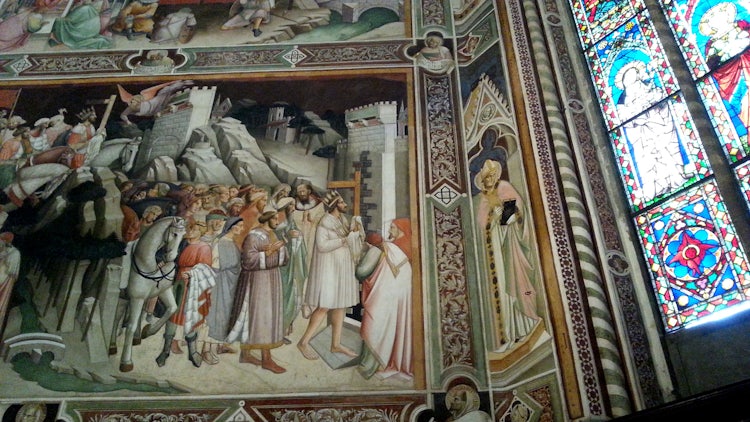
Chancel
Behind the main altar we find the work of Agnolo Gaddi (c.1350-1396), frescos depicting The Legend of the True Cross, the legend of the wood from the Garden of Eden becoming the Cross on which Jesus Christ was crucified, as it comes to us in the stories told in the book a Golden Legend. The book sought to compile traditional lore about all of the saints venerated at the time of its compilation (1280) and was considered a medieval "best seller" even out selling the Bible at one point. You can read the story as if it were a "fumetti" or portrayed in a comic book fashion; blocks of images that can be "read" starting from the top of the right hand wall to the bottom.
Bardi di "Mangona" or "Vernio" Chapel
Located all the way to the left of the chancel, this chapel depicts the works of San Silvestro, who was the consecrated bishop of Rome, and thus the Pope, a position he held for twenty-one years (from 31 January, 314 to his death in 335). Saint Sylvester's pontificate coincided with the long empire of Constantine I as well as when the empire was taking the first steps from paganism to christianity. With the colors and many detailed actors, not only do the fresco capture your attention, but also the Crucifix by Donatello, commonly called the "farmer" Crucifix, or what is also known as the "plowman" due to the rustic, peasant appearance of the Christ figure.
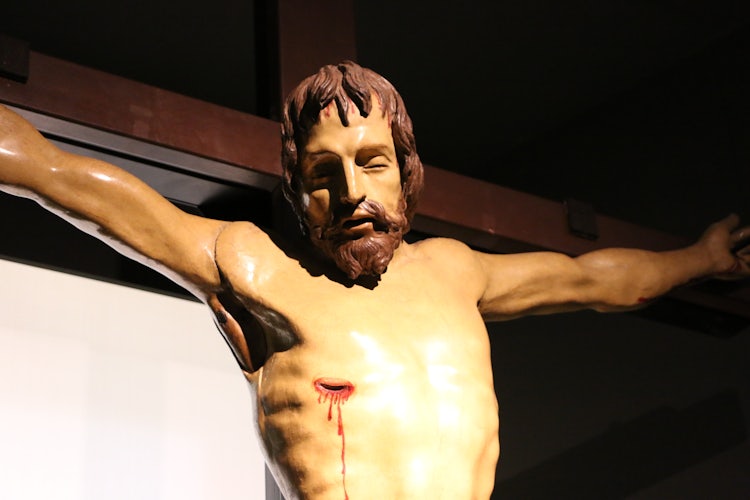
Castellani chapel
Within these hallowed walls there are chapels, monuments, plaques and tombs to commemorate a wide range of persons who have passed through Florence. The Castellani Chapel in particular honors Louise of Stolberg-Gedern:
who redefined the limits of 18th century gender roles by giving up the life of a ‘princess' and the connections afforded her by her husband's familial position, in order to save herself from domestic abuse and used the financial settlement from her legal separation to establish a home and intellectual salon with her Italian lover.
Her monument in Santa Croce poetically ensures that she live in eternity with her Florentine lover, whose tomb is between Michelangelo and Machiavelli.
The Baroncelli chapel
Some might recognise this name from the Pazzi Conspiracy, a crime so incredible that it is recorded as one of the most heinous in Florentine history; Bernardo Baroncelli planted a dagger in the chest of Giuliano de' Medici while at mass in the Cathedral of Florence. But that event was years after the sculpture Giovanni di Balduccio (c. 1290 - after 1339) made them tomb for the powerful Bandini Baroncelli family.
However, it is most probably the work of Taddeo Gaddi (c. 1290 - 1366) which will enchant: The Life of the Virgin. There artist Gaddi was a faithful student of Giotto, and he used the master's form of expression in colors and movement, to which he added a personal experimentation in the form of "architectural backgrounds" or what we might call still life. His stlye was a mix of Giotto and the accents he used for the:
rendering of the perspective of the buildings and of the depiction of three dimensional objects, like the fake niches with liturgical objects … [and stairwells]
Peruzzi chapel
This work of art, which was lost and then re-found, is just as important as the family who commissioned it, the Peruzzi family. The very same family who controlled the Peruzzi bank which "was the second largest in Europe, with fifteen branches from the Middle East to London" - all of this power before the Medici began their climb to power. The artist, Giotto, a humble sheperd from Mugell , with his new style revolutionised style, broke with the traditional Byzantine style and introduced the technique of drawing accurately from life. The chapel
was dedicated to the Saints John the Baptist and John the Evangelist. The painting which decorates the walls was the first Giotto's intervention in Santa Croce which is supposed to be dated between 1317 and 1320
The frescos are in the second chapel to the right of the chancel. Due to a different approach for applying the colors, the fresco has not held up as well as the others; the cycle presents the parallel stories of St. John the Baptist on the left wall and of St. John the Evangelist on the right wall.

Bardi chapel
Located between the chancel (main chapel) and the Peruzzi chapel, these frescoes by Giotto were dedicated to the life of Saint Francis in six episodes. As was the case with the neighboring Peruzzi Chapel, these frescoes were also painted over in the 18th century, rediscovered in the 19th century, and then reworked - as was the tendency at the time. Today's restoration work takes a very different approach attempt to recuperate what is possible instead of recreating what was thought to have been there.
Giotto represents only 7 scenes from the saint's life here, and the narrative is arranged somewhat unusually. The story starts on the upper left wall with St. Francis Renounces his Father. It continues across the chapel to the upper right wall with the Approval of the Franciscan Rule, moves down the right wall to the Trial by Fire, across the chapel again to the left wall for the Appearance at Arles, down the left wall to the Death of St. Francis, and across once more to the posthumous Visions of Fra Agostino and the Bishop of Assisi.
Sacristy
This the room dedicated to the priest's preparation for a service, and where vestments and articles of worship are kept.
Cloister
there are three within the complex
Santa Croce hosts three cloisters, "a covered walk in a convent, monastery, college, or cathedral, typically with an open colonnade", each built in a different moment of time. This space was isolated from the frenetic city life and responsibilities of the monks within the church, and an ideal place for silent contemplation, prayer and meditation.
Arnolfo's cloister: also known as the cloister of the dead, since it held several tombs. The cemetery later became a garden surrounded by the classical cypress tree. (now the exit of the church visit) Built by Arnolfo di Cambio (dates) the same man responsible for the Castello di Poppi and the floorpan for Palazzo Vecchio
Primo Chiostro: designed by the same man, Brunelleschi, who projected and oversaw the construction of the dome at the cathedral however it was not completed until long after his death.
It is one of the most harmonious buildings of the Florentine Renaissance, and is decorated not by frescoes but by glazed terracotta roundels, made by Luca della Robbia and his followers.
Ancient cloister, sits in the shade of the bell tower, with cypress trees and tombs this cloister was the first to exit.
Pazzi Chapel
a perfect space with harmonious proportions
The chapel, used as the chapter house by Santa Croce friars, is preceded by an atrium, a sort of entrance hall, supported by six Corinthian columns placed next to the central arch. It is a rectangular layout containing one square room, covered by an umbrella-shaped dome, and two sides of the remaining space, each covered by a barrel vault with round windows.
...here you find the quintessential Brunelleschi [...] the chapel is not large, but it seems to hold the four corners of the earth...
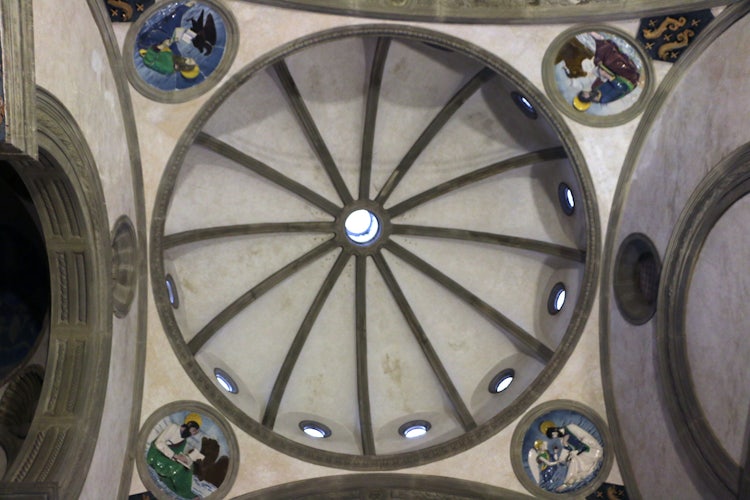
Tombs & Cenotaph
With so many things that make this church special, (the art, the architecture, the history), it may be that its reputation as the final resting place for so many important names through time which truly distinguish this church from others in Florence.
However, it was with the construction of the tomb of Michelangelo that the basilica became a favorite resting place of Italian greats and would earn its title as “The Temple of the Italian Glories.”
Michelangelo Buonarroti
Position: front entrance, to the right at the start of the side aisle
The burial site for Michelangelo was built in 1564/1574, (designed by Giorgio Vasari). He is surrounded by three allegorical statues representing his artistic strong points: Painting (by Giovan Battista Lorenzi), Sculpture (by Valerio Cioli) and Architecture (by Giovan Battista Lorenzi) all of three which are shown in mourning. Michelangelo died in 1564 in Rome, miles away from Santa Croce but that didn’t deter his admirers - who reportedly stole his bones so that they would be buried in Florence.
Dante Alighieri
Position: front entrance, to the right, just a third way down the side aisle
This incredible Tuscan poet was exiled from Florence for his political activities in 1302 and was not allowed to return. And if you ask, even though they are clamoring to have his physical remains returned, they still haven’t forgiven him for his “indiscretion”. This isn’t exactly a tomb but a cenotaph: an empty tomb or a monument erected in honour of a person or group of people whose remains are elsewhere.
Niccolò Machiavelli
Position: front entrance, to the right, halfway down the side aisle
Another citizen sitting who managed to upset the city who gave him a career and a home (like Dante). Though Machiavelli passed away in 1527, his tomb was not built until 1787 much like his famous book “The Prince”, which was never published until more than 10 years after his death. It bears the inscription, “Tanto nomini nullum par eulogium,” or “No elegy is equal to such a name.”
Galileo Galilei
Position: front entrance, to the left
Though he is not a native of this city, he did spend the later part of his life in Florence under the patronage of the Medicis giving him special status - at least for some. It was his beliefs about the earth revolving around the sun which created quite a bit of problems, even in death when he was not allowed a Christian burial. His monument was not constructed until 1737 when his remains were finally allowed to reside in the church.
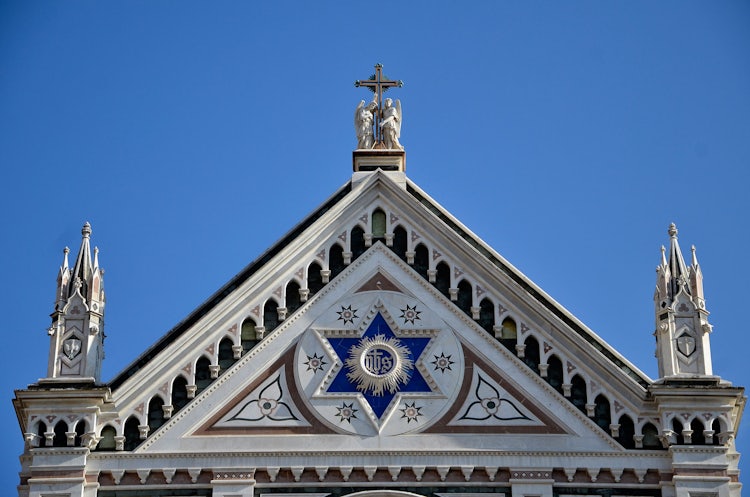
Museum
A collection of artwork which truly honors the years of masterpieces in Florence. Della Robbia ceramics to the frescoes by Jacopo Ligozzi, Andrea Orcagna and more work by Donatello.

